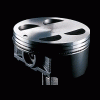-
Posts
168 -
Joined
-
Last visited
Content Type
Profiles
Forums
Gallery
Store
Everything posted by myles
-
I get the pop sound from time to time. I think it's caused by the ignition of unburned fuel in the cat. The smoke's probably not normal, and the dealer's lying and/or incompetent. Cars run _rich_ when cold, not lean. You see, oxygen sensors don't spring to life 'til they reach a certain temperature. Until then, the engine runs in open-loop mode, meaning the input from the oxygen sensor is not used to adjust the air-fuel mixture. To prevent a knock-inducing lean condition, the ECU errs on the side of caution and selects a slightly rich mixture. With the exception of the WRX STI, the all-wheel drive doesn't "kick in" on cars equipped with the manual transmission. The viscous coupling in the center differential will tend to equalize the speeds at which the front and rear axles turn, when the difference in speeds between the two is enough to shear the fluid enough to cause it to thicken. I doubt this is the source of the smell. Perhaps it's the smell of coolant cooking on a hot surface (exhaust)?
-

Baja Valves
myles replied to CROSSTBOLT's topic in 1990 to Present Legacy, Impreza, Outback, Forester, Baja, WRX&WrxSTI, SVX
AFAIK = as far as I know Sorry, I would've replied sooner, but you told me to "wait 'til Friday" (WTF) -

Baja Valves
myles replied to CROSSTBOLT's topic in 1990 to Present Legacy, Impreza, Outback, Forester, Baja, WRX&WrxSTI, SVX
A head with four valves per cylinder and a single cam can't use HLA's, AFAIK. I don't see a way for a single cam to act directly (via HLA's) on both the intake valves and exhaust valves. The SOHC uses "roller rockers". If memory serves, each intake valve gets its own rocker arm, and the pairs of exhaust valves get a Y-shaped rocker arm. Check out http://www.cobbtuning.com/tech/sohc/index.html -
In the US, two tests are used to determine a fuel's resistance to knock. I believe both tests use small, single-cylinder test engines. The one test results in a number called the "Research Octane Number" (RON). I believe this is what the Europeans and Aussies use. The other test results in a number called the "Motor Octane Number". The average of these two numbers is called the Anti-Knock Index (AKI). That's what we see posted on the pumps in the US. In fact, if you look closely at the pump, you'll see (R + M)/2 posted somewhere, which, of course, is saying that the number posted on the pump is the average of the Motor and Research Octane Numbers.

